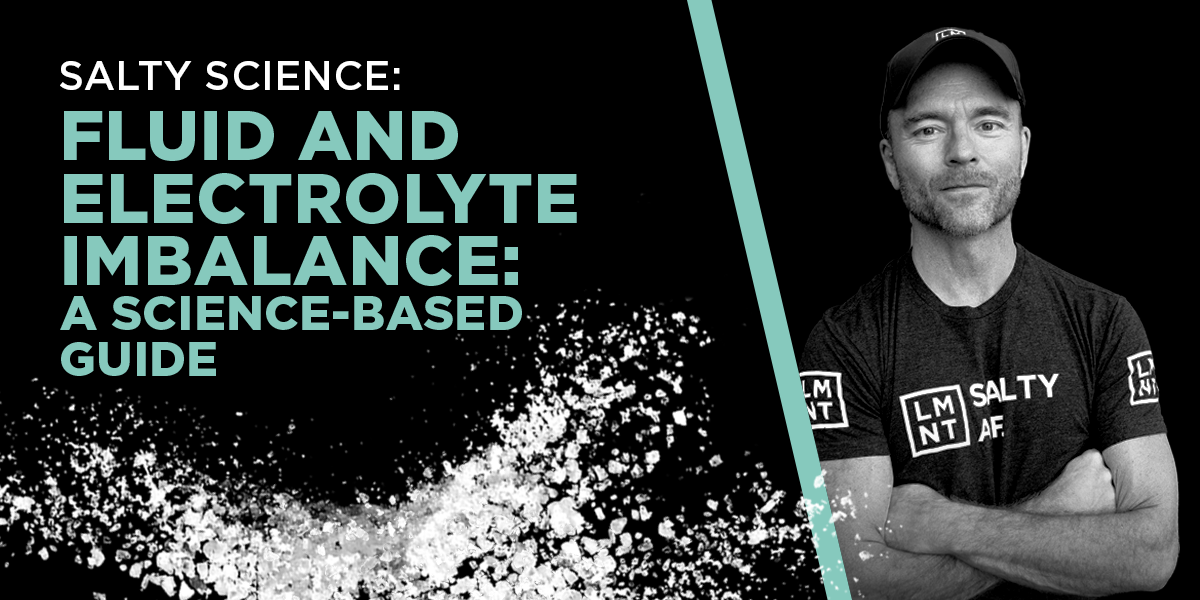When it comes to hydration, most people don’t think about preventing fluid and electrolyte imbalances. They merely think about drinking enough water.
This message has been drilled into our minds since childhood. To stay healthy, drink an 8 oz glass of water, 8 times per day. The problem is, there never was any science supporting this 8×8 rule. The real origin of this flaky myth is fairly pedestrian, and in fact the science indicates that drinking to thirst is sufficient in most circumstances.
In actuality, drinking too much plain water can dilute blood sodium, sometimes to dangerously low levels. The clearest example of this is the unfortunate marathon runners who experience confusion, light sensitivity, and even seizures at the finish line. These aren’t symptoms of fatigue, or even dehydration – they’re symptoms of overhydration.
Specifically, they’re indicative of exercise-associated hyponatremia. While hyponatremia is an electrolyte imbalance, it’s often treated as dehydration because the symptoms look similar. Yet drinking more water only worsens the condition. This isn’t just affecting elite athletes. Proper hydration can help all of us feel and perform our best, and that means dialing in fluid balance – so let’s start there.
What Is Fluid Balance?
Fluid balance refers to the distribution of fluids in your blood, organs, and other tissues. Proper fluid balance:
- Keeps your blood flowing smoothly through your blood vessels
- Keeps your brain floating in cerebrospinal fluid
- Keeps your skin moist and supple
- Helps you cool yourself with sweat
- Keeps your eyes lubricated with tears
Maintaining proper fluid balance is the goal of healthy hydration, not just preventing dehydration.
In most cases, your body handles mild disruptions like a champ. Even if you’re not thirsty, one extra glass of water won’t kill you. Your brain just suppresses antidiuretic hormone (ADH) and you pee out the excess.
And if you consume too much sodium (especially without liquids), your hypothalamus responds by making you feel thirsty. Then you drink something and fluid balance gets restored.
Let’s talk about what affects fluid balance now. Then you’ll have a better idea of how to stay hydrated.
What Affects Fluid Balance?
Your fluid balance system is designed to keep your body running like a German automobile. Some parts of this system (like water and electrolytes) are under your control, while others are not. I’ll start with the involuntary stuff.
#1: Brain, hormones, and kidneys
Most fluid balancing happens below the threshold of conscious awareness. The main players are:
- Your brain (especially the hypothalamus)
- Hormones (ADH, aldosterone, renin, angiotensin, etc.)
- Your kidneys
Your brain constantly monitors your blood osmolality (blood electrolyte concentration) and blood volume. When these become imbalanced, there are several ways your brain may restore order. It can play with ADH to retain or expel more fluids, play with aldosterone (secreted by the kidneys) to retain or expel more sodium, and trigger thirst. And all of those are just for starters.
The kidneys are the workhorse in this system. They do the dirty work—absorbing and expelling electrolytes and fluids to keep everything in balance.
Most of the time, this system works fine. But kidney failure, heart failure, drugs, illness, and unbalanced water and electrolyte intake are capable of disrupting it.
#2: Water intake
You never see an animal over-hydrating. They only drink when thirsty. That’s because thirst is a simple, effective indication that we need water. It’s incredibly good at preventing dehydration AND overhydration.
Your hypothalamus is the primary organ responsible for managing that thirsty feeling. Unless you have a condition that affects your ability to experience this sensation, I highly recommend listening to it.
Still, many people listen to another part of their brain: the part that’s been repeatedly told well-meaning, nonetheless bogus hydration advice. This part, untethered from physical cues, believes that more water is always better.
But too much plain water overwhelms the fluid balance system, causes sodium levels to plummet, and leads to symptoms we don’t want. That’s why we can’t neglect electrolytes.
#3: Electrolyte status
Drinking water is just one instrument in the fluid balancing symphony. You also have your hypothalamus, your kidneys, and a slew of hormones and electrolytes.
Electrolytes are charged minerals. They conduct electricity to power your nervous system, structure your skeleton, and regulate fluid balance.
Electrolytes (especially sodium and potassium) are part of the feedback loop that reports hydration status to your brain. Your body and brain are also ensuring you have enough electrolytes in the blood.
If you don’t, it’s red alert. Your bones get ransacked to normalize serum levels. That’s why most electrolyte deficiencies—sodium deficiency, potassium deficiency, magnesium deficiency, and calcium deficiency—are correlated with osteoporosis.[*][*][*][*]
When I talk about an electrolyte deficiency, I’m talking about suboptimal dietary intakes of a given electrolyte. Low dietary intakes alone won’t cause a true electrolyte imbalance, but they will increase the risk.
What Is an Electrolyte Imbalance?
An electrolyte imbalance is when blood levels of a given electrolyte get too low or too high. If the imbalance is severe enough, it may require medical attention.
Here are the medical terms for the various electrolyte imbalances:
- Hyponatremia (low serum sodium) and hypernatremia (high serum sodium)
- Hypokalemia (low serum potassium) and hyperkalemia (high serum potassium)
- Hypomagnesemia (low serum magnesium) and hypermagnesemia (high serum magnesium)
- Hypocalcemia (low serum calcium) and hypercalcemia (high serum calcium)
- Hypophosphatemia (low serum phosphate) and hyperphosphatemia (high serum phosphate)
The main causes of electrolyte imbalance include:
- Overhydration with plain water (dilutes blood sodium levels)
- Vomiting or diarrhea (both deplete potassium levels)
- Heart or kidney failure
- Medications (diuretics, laxatives, and others)
- Excessive alcohol usage
- Refeeding syndrome
- Vitamin D deficiency (can disrupt calcium levels)
You’ll notice that poor electrolyte intake isn’t on the list. Remember: if you don’t consume enough electrolytes, your body will pull them from your skeleton. Serum levels are that critical.
Why I Worry About Hyponatremia
Of all the electrolyte imbalances, I worry most about hyponatremia. Not only is it dangerous, but it’s a direct consequence of poor hydration habits.
Poor hydration habits are rampant. People drink water beyond the dictates of thirst much more often than you may think. It’s not their fault, of course. We’ve been taught to believe that it’s a wise and healthy practice. But even a few extra glasses of water could be harmful. Even mild hyponatremia can cause fatigue, low energy, malaise, muscle cramps, irritability, and weakness.
Severe hyponatremia is where things truly become scary. Confusion, seizures, brain damage, light sensitivity, brain swelling, and sometimes even death can occur. Many elite athletes have perished from this condition.
Just think how a marathon course is set up. Watering stations every couple of miles. Should we be surprised that about 15% of competitors develop exercise-associated hyponatremia?
The idea is to prevent dehydration (net water loss from the body). But optimizing to prevent dehydration is misguided because:
- Athletes perform fine in a dehydrated state
- There are no sports-related deaths from dehydration in all the medical literature. (And there are many reported deaths from low serum sodium.)
- Aggressively hydrating with plain water increases the risk of hyponatremia
Here’s the deal. Humans are meant to become slightly dehydrated when we sweat. It’s biologically normal, and it doesn’t appear to affect performance.
What’s not normal is aggressive fluid replacement. That’s how you cause a fluid and electrolyte imbalance. Let’s talk about preventing them now.
How To Prevent a Fluid and Electrolyte Imbalance
The goal of healthy hydration is to maintain proper fluid balance. How should you go about doing that?
Medical and pharmacological considerations aside, there are just two principles to follow:
- Consume adequate fluids
- Consume adequate electrolytes
To consume adequate fluids, simply drink to thirst. There are some exceptions (cold weather, altitude, age-related thirst impairment), but drinking to thirst is generally sufficient.
Consuming adequate electrolytes requires more strategy. Start by eating electrolyte-rich foods for potassium, magnesium, and calcium—then salt those foods liberally for sodium and chloride.
My favorite electrolyte sources are green leafy vegetables like spinach, chard, and kale. You can’t go wrong eating tons of greens.
Yet diet and salt alone may not cut it. If you eat a whole foods diet, low-carb diet, exercise consistently, enjoy the sauna, or all of the above—you’re going to need more sodium.
Five grams of daily sodium is a good baseline. Go up from there, however, if you’re still having low sodium symptoms like fatigue, headache, or cramps. One to two extra grams can make a huge difference in how you feel and perform—and the cool part is that you can feel the difference almost immediately.
To bump up your sodium, just add salt to your water. If you want a tastier option, add LMNT. It contains 1000 mg sodium, 200 mg potassium, 60 mg magnesium, and zero sugar per stick.
And so if you want to optimize fluid balance, drink electrolyte water to thirst in the context of an electrolyte-rich diet. Your body will appreciate it.

